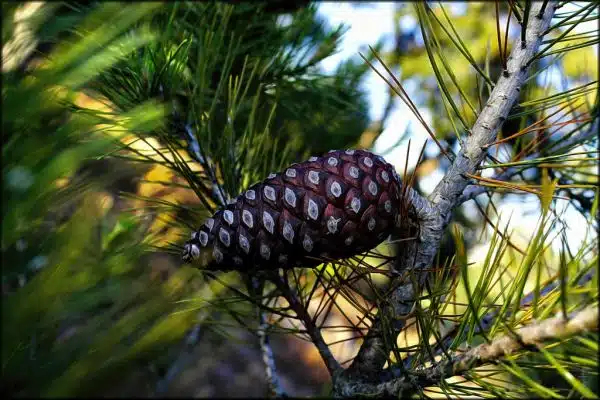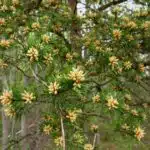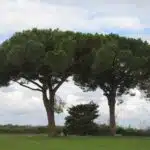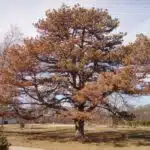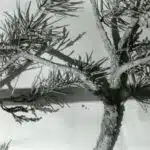Aleppo Pine (Pinus halepensis) is a popular evergreen tree that originates from the Mediterranean region. It has been widely used in landscaping and gardening due to its aesthetic value, drought tolerance and resilience against pests and diseases. Aleppo Pine is an ideal species for arid and coastal regions where other trees may struggle to grow. However, proper care and maintenance are necessary for the tree to thrive and reach its full potential.
In this article, we will discuss the key factors involved in growing and caring for Aleppo Pine. We will cover topics such as soil requirements, watering needs, fertilization, pruning techniques, disease prevention, and pest control. By following these guidelines, homeowners and landscapers can ensure that their Aleppo Pines remain healthy, beautiful, and beneficial to the environment. Whether you are planting a new tree or maintaining an existing one, our tips will help you foster a strong and sustainable relationship with this majestic species.
Overview Of Aleppo Pine
Aleppo Pine, also known as Pinus Halepensis, is a species of pine tree native to the Mediterranean region. It has been cultivated for centuries due to its many uses such as timber, fuel, and resin extraction. Aleppo Pine is a medium-sized evergreen tree that can grow up to 20 meters high with a rounded crown of bluish-green needles.
History and Folklore surround the Aleppo Pine as it has been mentioned in ancient texts such as the Bible and was used by ancient Greeks and Romans for various purposes. The pine cones were even believed to be thrown into the fire during winter solstice celebrations to symbolize the return of light and warmth. In addition, folklore suggests that the pine needles were used by Roman soldiers to make tea for their medicinal properties.
Symbolism and Significance are also associated with Aleppo Pine. It is often seen as a symbol of resilience due to its ability to grow in harsh environments such as rocky slopes and poor soil conditions. Additionally, it is a significant species in reforestation efforts following wildfires or other natural disasters due to its fast growth rate and ability to withstand drought conditions.
Moving on from this introduction, we will now delve into the climate and soil requirements needed for growing healthy Aleppo Pines.
Climate And Soil Requirements
Aleppo pine is a sturdy tree that can withstand harsh environmental conditions, including drought and salt spray. However, it still needs specific climate and soil requirements to thrive. The best locations for Aleppo pine are in areas with a Mediterranean climate, characterized by hot summers and mild winters, such as California or parts of Southern Europe.
Soil preparation is crucial when planting an Aleppo pine tree. The soil should be well-drained, slightly acidic to neutral (pH 6-7), and free of weeds and other plants that could compete for nutrients. It’s recommended to mix the soil with organic matter like compost or mulch to improve its water retention capacity, nutrient content, and overall structure.
Additionally, adding fertilizers can also help boost the growth of your Aleppo pine tree. Fertilizers rich in nitrogen can encourage new growth while those high in phosphorus will promote root development. A balanced fertilizer with equal amounts of nitrogen, phosphorus, and potassium will provide all the necessary nutrients for healthy growth.
Now that we know the appropriate climate and soil requirements for growing Aleppopine trees let’s move on to choosing the right location.
Choosing The Right Location
When selecting a location for an Aleppo pine, it is important to ensure that the site receives ample sunlight. The tree requires at least 6 hours of direct sunlight each day in order to thrive and grow. Additionally, the soil should have good drainage so that the roots do not become waterlogged, as this can cause root rot. To ensure the best health of the tree, it is important to choose a site that is well-drained and receives ample sunlight.
Sunlight
Sunlight is an essential factor to consider when choosing the right location for growing and caring for Aleppo pine. This tree species requires full sunlight exposure to thrive and maintain its health. Hence, it is recommended to plant it in areas with high sunlight intensity, which can provide optimal growing conditions for the tree.
However, it is important to note that seasonal variations can affect the amount of sunlight that reaches the tree. During the summer months, when the days are longer and sunnier, Aleppo pine can receive more than enough sunlight exposure. Conversely, during the winter months when daylight hours are shorter, the tree may receive less sunlight. Therefore, it’s crucial to monitor seasonal variations in sunlight intensity and adjust your maintenance practices accordingly.
To ensure that your Aleppo pine receives adequate sunlight throughout all seasons, you should consider planting it in an open area where it can receive direct sunlight from all angles. You should also prune surrounding trees or structures that may obstruct its access to light. By choosing a suitable location with sufficient sunlight exposure and monitoring seasonal variations, you can grow and care for a healthy and vibrant Aleppo pine tree.
Drainage
When it comes to choosing the right location for growing and caring for Aleppo pine, there are several factors that you should consider. One of these factors is drainage. Adequate drainage is essential for the health and growth of most trees, including the Aleppo pine. Poor drainage can lead to root rot, which can be fatal for the tree.
To ensure proper drainage, you should choose a location with well-draining soil. If your soil is heavy or clayey, you may need to improve its drainage by adding soil amendments such as sand or gravel. Additionally, you should avoid planting your Aleppo pine in low-lying areas where water tends to accumulate.
Regular monitoring of your tree’s surroundings is also crucial in improving drainage conditions. You should remove any debris or leaves that may obstruct water flow around the tree’s base. By taking these steps to improve drainage conditions, you can help ensure that your Aleppo pine grows and thrives in a healthy environment.
Watering And Irrigation
Watering and irrigation are crucial factors in the growth and care of Aleppo pine trees. The frequency and amount of water needed will depend on various factors such as climate, soil type, and tree age. Young trees require more water than mature ones, while hotter and drier climates necessitate more frequent watering.
One effective way to ensure adequate watering is through drip irrigation. Drip irrigation is a system that delivers water directly to the tree’s root zone through a network of tubes with small emitters or holes that allow water to slowly drip out. This technique minimizes water waste by reducing runoff, evaporation, and overspray. Additionally, it allows for better control over the amount of water delivered to the tree, ensuring optimal moisture levels without overwatering.
Water conservation techniques should also be employed when growing Aleppo pine trees. These methods include using mulch to retain moisture in the soil, avoiding watering during peak evaporation hours, and collecting rainwater for later use. In addition, monitoring soil moisture levels regularly can help prevent overwatering and minimize the risk of disease or pest infestation.
Moving on to fertilization and nutrient management, it is critical to note that proper nutrition is key in promoting healthy growth in Aleppo pine trees. A balanced fertilizer with essential nutrients such as nitrogen (N), phosphorus (P), potassium (K), magnesium (Mg), and iron (Fe) should be applied at appropriate intervals throughout the year. Overfertilization can lead to excessive growth, making the tree more susceptible to pest infestations or diseases. Therefore, it is imperative to follow recommended guidelines regarding application rates and timing when fertilizing Aleppo pine trees.
Fertilization And Nutrient Management
One way to ensure healthy growth for Aleppo Pine is through proper fertilization and nutrient management. For instance, imagine a hypothetical situation where an Aleppo Pine tree is growing in a garden with poor soil quality. In this case, the tree may not be getting enough nutrients from the soil to grow optimally. If not addressed promptly, it may lead to stunted growth and other related issues.
To prevent such scenarios, here are three important ways to manage fertilization and nutrient uptake in Aleppo Pine trees:
Organic fertilizers: Using organic fertilizers can help provide essential nutrients that promote healthy growth while also improving soil quality over time. Examples of organic fertilizers include fish emulsion, bone meal, and composted manures.
Composting techniques: Creating a compost heap using fallen leaves, branches, and other organic matter around the base of the tree can also be beneficial as it slowly releases nutrients back into the soil.
Soil testing: Regular soil testing helps determine any nutrient deficiencies or imbalances that need addressing. By understanding what nutrients are lacking or in excess, arborists can tailor their fertilizer applications accordingly.
In summary, proper fertilization and nutrient management are essential for maintaining healthy Aleppo Pine trees. Utilizing organic fertilizers and composting techniques while performing regular soil tests will help ensure that these trees receive optimal nutrition throughout their lifespan. The subsequent section will discuss pruning and shaping techniques to further promote healthy growth in these trees.
Pruning And Shaping
- Pruning and shaping aleppo pine correctly is essential for creating a healthy and aesthetically pleasing tree, as well as controlling its height and width.
- Pruning and shaping should be done at the right time of the year and with the right tools, while taking care to cut branches at the right angle and avoid cutting too much deadwood.
- Proper growth of an aleppo pine can be encouraged by providing adequate sunlight, watering, fertilizing and mulching, as well as training it to grow in the desired form.
- If done correctly and consistently, pruning and shaping can help to create a safe and beautiful tree that will last for years.
Pruning
Pruning is a crucial aspect of caring for Aleppo pine trees. This process involves removing dead, diseased or damaged branches to promote growth and maintain the health of the tree. Pruning should also be done to remove any crossing or rubbing branches that can cause wounds on the trunk.
When pruning Aleppo pines, it’s important to use proper techniques to avoid damaging the tree. Start by removing any dead or diseased branches at their point of origin. Use clean, sharp pruning tools to make clean cuts without tearing the bark. Avoid cutting too close to the trunk as this can cause damage and leave the tree vulnerable to infections.
Shaping methods are also used during pruning to give Aleppo pines an attractive form that suits its surroundings. This can involve removing lower branches or shaping the canopy to allow more sunlight penetration. It’s important not to remove too many branches at once as this can stress the tree and affect its growth. Regular pruning will improve the overall appearance of Aleppo pine trees and help them stay healthy for years to come.
Shaping
Pruning is an essential practice in tree care, and it involves the removal of dead or diseased branches to promote growth and maintain the health of a tree. Proper pruning techniques are important to avoid damaging the tree, and it can also be used to shape trees for aesthetic appeal. Shaping is another aspect of pruning that involves removing lower branches or trimming the canopy to allow more sunlight penetration.
Shaping methods during pruning are crucial in achieving an attractive form that suits its surroundings. It’s important to note that shaping should not compromise the health of the Aleppo pine tree. Arborists use a combination of pruning techniques such as thinning cuts, heading cuts, and directional cuts, depending on the objectives. Thinning cuts are made to remove branches at their bases while heading cuts shorten branches from their tips. Directional cuts are made above buds facing outward in a chosen direction.
Regular pruning and shaping will improve the overall appearance of Aleppo pine trees while keeping them healthy for years to come. However, excessive removal of branches at once can stress trees and negatively affect their growth; hence it’s recommended not to remove more than 25% of live foliage at any one time. Aesthetic appeal is not only essential for homeowners but also beneficial for commercial landscaping purposes by improving curb appeal and increasing property value. In conclusion, proper shaping methods during pruning are necessary for maintaining healthy Aleppo pine trees with desirable aesthetics.
Disease Prevention And Treatment
Preventing diseases in Aleppo pine trees is an essential part of their care. One effective way to prevent diseases is through proper pruning techniques. By removing dead, diseased, or damaged branches, you can reduce the chances of infection spreading throughout the tree. It is also important to keep the tree healthy by providing it with adequate water and nutrients.
If your Aleppo pine does become infected with a disease, there are natural remedies and chemical treatments available. Natural remedies such as compost tea or neem oil can be applied to the affected areas to help control the disease. Chemical treatments may also be necessary, but it is important to use them carefully and follow all instructions on the label. Always consult with a professional arborist before using any chemical treatments on your trees.
Proper disease prevention and treatment are crucial for maintaining the health and longevity of your Aleppo pine tree. Regular inspection of your tree for signs of disease can help catch any problems early on before they become more severe. By taking proactive measures such as pruning and using natural remedies or chemical treatments when necessary, you can ensure that your tree remains healthy for years to come.
Moving forward into pest control strategies, it is important to note that preventing pests is often closely tied to preventing diseases in trees. By keeping your Aleppo pine tree healthy and well-maintained, you can reduce its susceptibility to both pests and diseases.
Pest Control Strategies
Like any living organism, the Aleppo pine is susceptible to pest infestations. These pests can wreak havoc on your tree’s health and potentially kill it if left unchecked. It’s important to be vigilant in pest prevention and control measures, much like how a doctor would prescribe preventative medicine for their patients.
One natural remedy for pest control is introducing ladybugs or lacewings into your garden. These insects prey on aphids and other harmful pests that can harm your Aleppo pine. Additionally, regular pruning of dead or diseased branches can prevent infestations from taking hold. However, if the infestation is severe or persistent, it may be necessary to seek professional pest control services.
When seeking professional help, it’s essential to choose a reputable arborist who specializes in tree care. They will have the knowledge and expertise to identify the specific pests affecting your Aleppo pine and recommend appropriate treatment options. While chemical pesticides are an option, they may harm beneficial insects and wildlife in your garden. A knowledgeable arborist will consider all options before prescribing a course of action.
As important as pest control is for maintaining healthy trees, propagation and planting techniques are just as crucial for ensuring success in growing new ones. So let’s discuss some effective methods for propagating the Aleppo pine!
Propagation And Planting Techniques
- Aleppo pines, native to the Mediterranean region, are propagated from seeds that can be collected in the late summer or early fall.
- A planting depth of approximately 2 cm is recommended for Aleppo pine seeds.
- To ensure optimum growth, the soil should be kept moist but not wet for Aleppo pines.
- The soil should also be well drained, as Aleppo pines can suffer from root rot if the soil is waterlogged.
- Applying a 2-3 cm layer of mulch around the base of the Aleppo pine can help to maintain a consistent soil moisture level.
- The soil should be monitored regularly to ensure that the Aleppo pine is not exposed to overly wet or dry conditions.
Seed Collection
Harvesting methods are critical when collecting Aleppo pine seeds. Arborists and tree care specialists must ensure that the cones are mature enough to collect the seeds. The cones should be brown and open, indicating that they have released their seeds. For optimal seed collection, it is essential to pick the cones immediately after they have opened.
The germination process of Aleppo pine seeds can be challenging. Before planting, it is crucial to stratify the seeds for at least 30 days in a cold environment between 0-5°C. This process helps break seed dormancy and improve germination rates. After stratification, sow the seeds in a well-draining soil mix with good moisture retention properties.
It is vital to maintain consistent moisture levels during germination. Overwatering or underwatering may affect the germination rate negatively. It takes approximately two weeks for the Aleppo pine seedlings to emerge from the soil. This method of propagation is cost-effective and guarantees that new trees will be genetically identical to their parent plants. By following these guidelines, arborists and tree care specialists can propagate healthy Aleppo pines with ease.
Planting Depth
As an arborist or tree care specialist, it is essential to have a comprehensive understanding of the propagation and planting techniques of trees. One crucial aspect of this process is determining the proper planting depth for Aleppo pine seeds. Planting depth refers to the distance between the surface of the soil and the top of the seed. Proper spacing promotes healthy growth and development of seedlings. Common mistakes made during planting include burying seeds too deep or not deep enough, which can lead to poor germination rates or stunted growth.
The recommended planting depth for Aleppo pine seeds is approximately 2-3 times their diameter, which is about 1-2 cm deep. Planting seeds too shallowly may cause them to dry out quickly, while placing them too deeply may hinder their ability to emerge from the soil. It’s also important to ensure adequate spacing between individual seeds or seedlings when planting in containers or open ground.
One common mistake made during planting is overcrowding or placing multiple seeds in one spot. This practice can lead to competition for resources such as light, water, and nutrients, and negatively impact growth rates. Proper spacing ensures that each seed has enough room to grow without being overshadowed by neighboring plants. By following these guidelines and avoiding common mistakes during planting, arborists and tree care specialists can ensure successful propagation and healthy growth of Aleppo pines.
Moisture Level
To ensure successful propagation and planting of Aleppo pine seeds, arborists and tree care specialists must consider various factors that contribute to their growth and development. One crucial aspect is the moisture level in the soil, which affects the germination rate and overall health of seedlings. Proper watering frequency and soil drainage are essential components of maintaining optimal moisture levels.
Watering frequency is crucial for promoting healthy growth in Aleppo pine seeds. Underwatering can lead to dry soil, which inhibits germination, while overwatering can cause root rot or fungal diseases. The frequency of watering depends on several factors, including the climate, season, soil type, and container size. In general, it’s best to water when the top inch of soil feels dry to the touch. However, it’s important not to let the soil become bone-dry between watering sessions.
Soil drainage is another critical factor in maintaining proper moisture levels for Aleppo pine seeds. Poorly-draining soils can lead to waterlogged conditions that suffocate roots and promote fungal growth. On the other hand, excessively well-draining soils may not retain enough moisture for seedlings to establish themselves properly. Arborists should aim for a balance between water retention and drainage by selecting a well-draining soil mix with adequate organic matter content or adding amendments such as perlite or vermiculite if necessary. By monitoring watering frequency and ensuring proper soil drainage, arborists can provide optimal growing conditions for Aleppo pines during their early growth stages.
Benefits And Uses Of Aleppo Pine
Aleppo pine is a beautiful evergreen tree that is native to the Mediterranean region. It is also known as the Jerusalem pine, and it can grow up to 20 meters tall. This tree has been widely used for its medicinal properties and culinary uses.
One of the benefits of Aleppo pine is that it can help treat respiratory problems such as bronchitis and asthma. The needles of this tree contain essential oils, which have antiseptic and expectorant properties. These oils can help loosen phlegm and ease breathing.
In addition to its medicinal properties, Aleppo pine has culinary uses too. The cones of this tree are edible, and they have a slightly sweet taste. They can be roasted or boiled, and they make a great addition to salads or stews.
- The resin from Aleppo pine has been used in traditional medicine for its anti-inflammatory properties.
- The wood from this tree is strong and durable, making it ideal for construction purposes.
- Aleppo pine forests provide shelter for many animal species.
- This tree helps prevent soil erosion by stabilizing slopes.
- The essential oil from the needles is used in aromatherapy to promote relaxation.
Overall, Aleppo pine is an excellent choice for those who want a beautiful evergreen tree with medicinal properties and culinary uses. Its ability to treat respiratory problems makes it a valuable addition to any garden or landscape. Whether you are looking for an attractive plant or something that provides health benefits, Aleppo pine offers both.
Conclusion
Aleppo Pine, a popular species for landscaping and forestry, requires specific care to thrive. It is important to consider the climate and soil requirements before planting, as well as selecting an appropriate location. Moisture management is crucial, as these trees do not tolerate droughts well. Fertilization and disease prevention also play a key role in maintaining healthy growth.
In terms of pest control, preventative measures should be taken to avoid infestations from bark beetles and other harmful insects. Propagation can be done through seed or cuttings, and proper techniques should be used during planting to ensure successful growth.
As arborists, we understand the importance of caring for trees properly to optimize their benefits. The Aleppo Pine provides not only aesthetic value but also serves as a source of lumber and produces pine nuts. As the old adage goes, “you reap what you sow.” By investing time into proper care techniques, we can enjoy the beauty and benefits of this resilient species for years to come.
Image Credits
- “Aleppo pine (Pinus halepensis)” by Daniel Arrhakis (featured)

